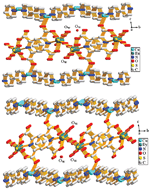A new family of 3D 3d–4f heterometallic frameworks comprising 1D inorganic lanthanide ladders and organic CuI-bipyridine chains†‡
Abstract
A new family of the 3D heterometallic coordination

* Corresponding authors
a
Institute of Chemistry and Chemical Engineering, University of Jinan, Jinan, China
E-mail:
chm_boqb@ujn.edu.cn
Fax: +86-531-87161600
b Division of Chemistry, Luleå University of Technology, SE 971 87 Luleå, Sweden
A new family of the 3D heterometallic coordination

 Please wait while we load your content...
Something went wrong. Try again?
Please wait while we load your content...
Something went wrong. Try again?
Q. Bo, Z. Sun and W. Forsling, CrystEngComm, 2008, 10, 232 DOI: 10.1039/B710786B
To request permission to reproduce material from this article, please go to the Copyright Clearance Center request page.
If you are an author contributing to an RSC publication, you do not need to request permission provided correct acknowledgement is given.
If you are the author of this article, you do not need to request permission to reproduce figures and diagrams provided correct acknowledgement is given. If you want to reproduce the whole article in a third-party publication (excluding your thesis/dissertation for which permission is not required) please go to the Copyright Clearance Center request page.
Read more about how to correctly acknowledge RSC content.
 Fetching data from CrossRef.
Fetching data from CrossRef.
This may take some time to load.
Loading related content
